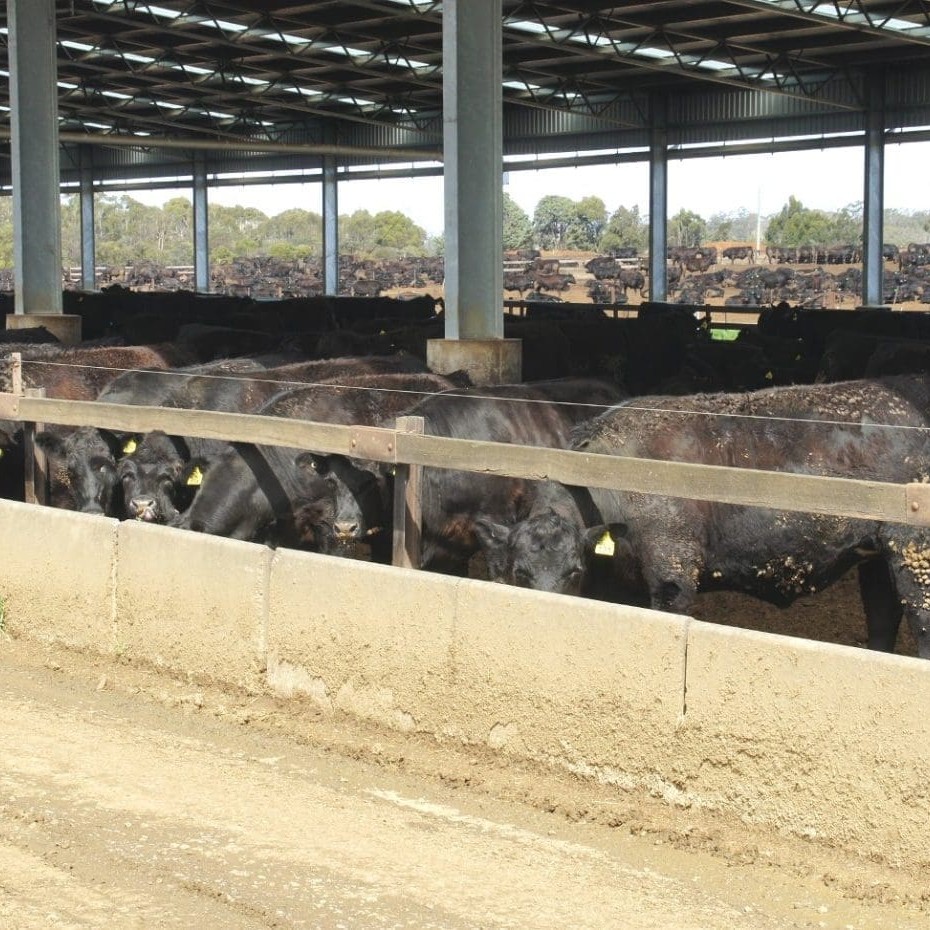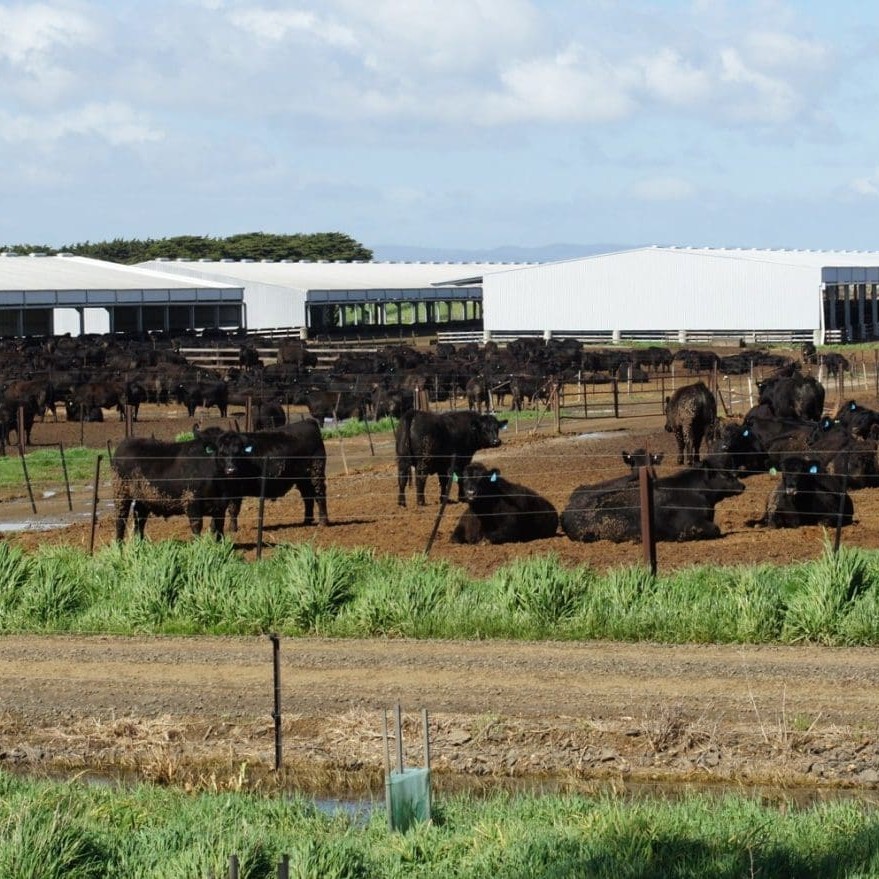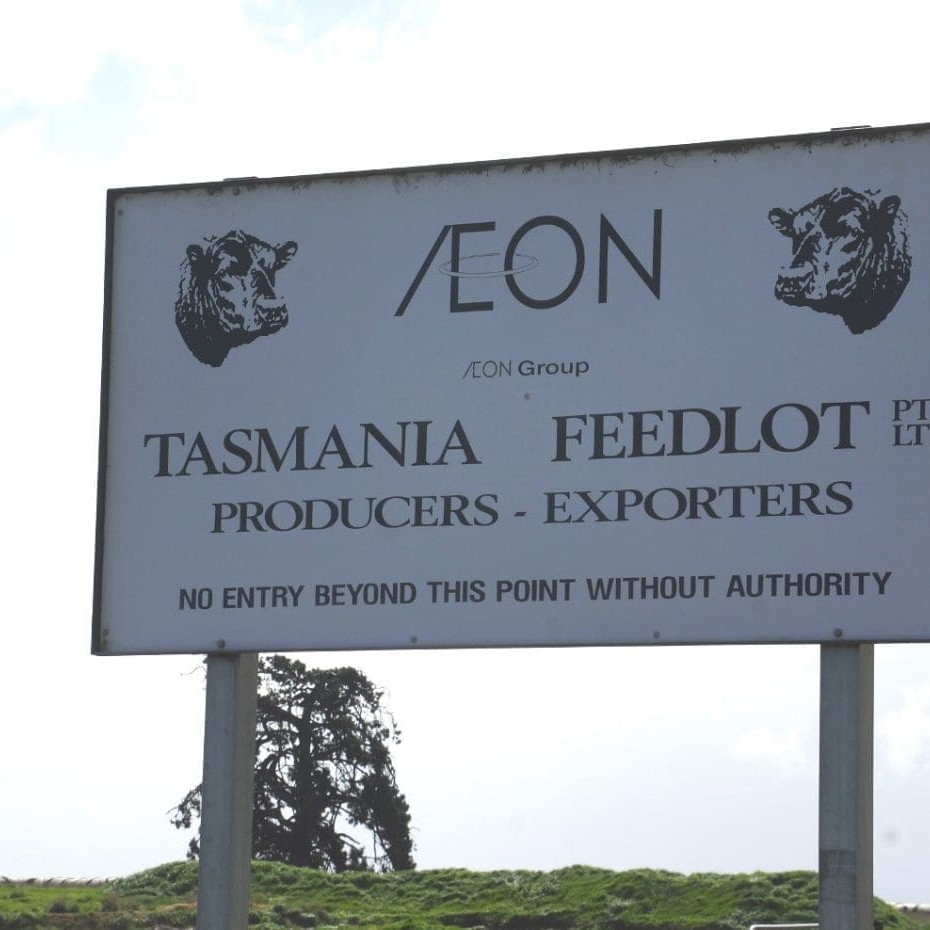Australia’s southernmost feedlot has made another big investment in shedding infrastructure, motivated by the impact it has achieved earlier in reducing dag loads on hides at slaughter, plus improvements in weightgain performance, both summer and winter.
Tasmania feedlot is the island state’s only commercial feedyard – a unique facility developed over the past 40 years by Japan’s Aeon Group, which operates the large Jusco supermarket chain.
 The facility south of Launceston completed construction of its third large feedlot shed in April, providing dry conditions underfoot and protection from the elements for an additional 800 head of feeder cattle, housed in four 200-head pens.
The facility south of Launceston completed construction of its third large feedlot shed in April, providing dry conditions underfoot and protection from the elements for an additional 800 head of feeder cattle, housed in four 200-head pens.
The latest project follows two similar sheds (each 120m x 240m) built six years ago, delivering total shedded cattle capacity at the site now of around 2000 head.
Given the range of productivity and management benefits delivered, the latest $1 million investment in shedding is anticipated to have a payback period of just three to five years.
While the provision of permanent shedding for feedlot cattle is commonplace in countries like Japan and South Korea, it remains rare in Australian lotfeeding operations. Shadecloth-based sun protection is common in some feedlot environments where it provides benefit from heat stress risk, but the number of feedlots in Australia with permanent shedding for stock can be counted on one hand.
What sets the Tasmania feedlot apart is its high average annual rainfall – possibly the highest of any feedlot location in Australia, at more than 660mm – and low evaporation, which is the underlying reason why the original investment in shedding was made.
Feedlot manager Allan Howard told Beef Central during a recent inspection that originally the business had faced a considerable battle with its heavy-coated Angus cattle carrying heavy dag loads over the wet winter months, particularly.
While the Tasmania feedlot’s licensed capacity remains unchanged at 14,000 head, the additional shed infrastructure built this year allows cattle to spend the final 35 days of their feeding program under shelter, on woodchip or sawdust bedding. This has virtually eliminated the dag problem prior to slaughter, and the cattle viewed during our recent inspection that were about to exit the feedyard were particularly clean-coated, despite the big recent rainfall across northern Tasmania since August.
“Originally we looked at putting in a mechanical washer or employing people to try to wash-off the dags the day before slaughter, but it wasn’t economically viable,” Mr Howard said.
Dirty cattle carrying heavy dag burdens can suffer heavy cost penalties at the meatworks from having to shear ‘cut lines’ before slaughter to lessen the risk of bacterial contamination from dags during the manufacturing process.
Helping in the dag removal process is the provision of woodchip/sawdust bedding, with more than 45,000 cubic metres of bedding material laid down in both ‘indoor’ and ‘outdoor’ pens each year, at significant cost.
While bedding in external pens is replaced fortnightly during wetter times of year, bedding in the shed complex requires replacement only every six weeks, which in itself represents a large cost saving. All of the bedding material and pen waste removed at cleaning is composted and sold for nursery and landscaping use.
Gains in cattle performance
An important secondary benefit from the shed installations comes in cattle comfort. Winter temperatures in the sheds are 5-6 degrees C warmer than outside pens, and summer temperatures are 5-6 degrees cooler, Mr Howard said.
 This delivers considerable productivity improvements in both average daily gain and feed consumption. Cattle typically put on another 100 grams (0.1kg) per day in ADGs, across both summer and winter cycles due to lack of exposure to wind and cold temperatures in winter, and shade during the hotter months.
This delivers considerable productivity improvements in both average daily gain and feed consumption. Cattle typically put on another 100 grams (0.1kg) per day in ADGs, across both summer and winter cycles due to lack of exposure to wind and cold temperatures in winter, and shade during the hotter months.
Cattle housed in the sheds during the final 35 days of their feeding programs gain at around 1.75kg/day, compared with 1.65kg in the outside pens, on a year-round average.
Feed consumption also produces an advantage due to lower body maintenance requirements.
Another handy ‘by-product’ of the shed facilities is the ability to harvest the water off the roofs. This produces about 45 megalitres of potable stockwater each year – a significant resource, when capital cost to supply water can cost $1000 a meg, Mr Howard said.
The Tasmania feedlot is on track to turn off 16,000 fed cattle for the year – all straightbred high-performance Angus steers procured from a network of regular suppliers across the Tasmanian ‘mainland’ and Flinders and King Islands.
The standard feeding program for the Aeon/Jusco supermarkets program is 165 days, minimum marbling score of 2, but with many now hitting scores of 3-4 with growing consistency. Barley is the primary grain component, plus lucerne and cereal straw.
The other, more unconventional ration component is potato by-product, drawn from nearby food processing operations. This by-product is ensiled for 30-days to stabilise starches and improve digestibility. On a dry matter basis, the starch-rich potato silage is equivalent to grain, and represents an invaluable, cost-effective feedstuff resource.
Another big advance made three years ago was a move from simple dry-rolling to steeping, raising grain moisture levels to 20pc before rolling, which is delivering substantial productivity benefits in grain utilisation.
Another tool used in the phyto-sanitary management process is the addition to the ration of the dried yeast additive, Beef Culture, an AAP product which effectively reduces the e.coli count in the gut, and hence provides a buffering effect against later contamination.
The dried yeast is simply mixed with water and sprayed onto the feed to administer.
The cattle at close-out go two ways, with about 80pc being processed at the nearby JBS Longford plant, and the balance through HW Greenham’s Smithton plant, further west. In combination, that represents about 340 bodies each week.
Most of the production is directed into Japan for use through the huge national network of Jusco supermarkets, but a little finds its way via Japan into Malaysia and China.
Jusco supermarkets in Japan are renowned for developing and operating some of the most comprehensive individual animal traceability systems in the retail world.
The product is sold in Japan with a clear, high-profile identity as being Tasmanian in origin, with a prominent reference from the Tasmanian State Premier about the HGP-free and antibiotic free, GM-free status of the product as part of the brand message.
Genetic performance continues to improve
With 40 years of feeding behind it, Tasmania feedlot provides a useful snapshot of the gradual improvement in feedlot performance of straightbred Angus cattle, on which the business is totally reliant.
 In no small way, the demand signals from the feedlot has been a major contributor to Tasmania’s beef cattle ‘turning black’ over the past 20 years.
In no small way, the demand signals from the feedlot has been a major contributor to Tasmania’s beef cattle ‘turning black’ over the past 20 years.
“We’ve seen a big change in the general performance of Angus feeders over that time,” Mr Howard said.
“That’s reflected not only in more consistent and higher marbling performance, but in consolidation of performance in daily gains, carcase weights (averaging 360-370kg across the yearly cycle), better muscling, and reasonably good feed conversion along the way, as well.”
“Frame size probably got just a little too big at one earlier stage among some breeders, but that’s been moderated now to a more acceptable level; but it’s in feed conversion rates where the recent advances have been quite noticeable.”
